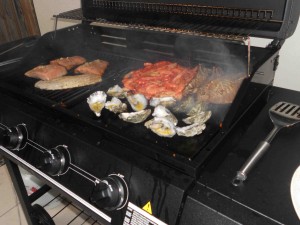Asher Klein of NBC Boston reports a man who allegedly coughed and spit at a Stop & Shop in Kingston, Massachusetts, before getting into a fight there Saturday afternoon has been taken to a hospital for evaluation and may face charges, police said.
 A witness to the incident said the man was coughing and spitting on food at the supermarket. He shared video to Facebook showing two men holding another one down, with one of Stop & Shop’s hazard-spotting robots hovering nearby.
A witness to the incident said the man was coughing and spitting on food at the supermarket. He shared video to Facebook showing two men holding another one down, with one of Stop & Shop’s hazard-spotting robots hovering nearby.
“Some guy at Stop and Shop in Kingston was coughing and spitting on the produce, he didn’t last long. He fought an employee and good customers took him down until the cops arrived,” the witness, Kyle Mann, wrote in the post.
Store officials have discarded potentially affected product and conducted a deep cleaning and sanitizing of all impacted areas, according to the statement. Additionally, the Board of Health has inspected the store and affirmed it is safe for shoppers.
The accused spitter has been told that police are moving to accuse him of crimes that may involve assault and battery and destroying property.
A Pennsylvania grocery store had to throw out tens of thousands of dollars worth of food late last month after a woman walked inside and “proceeded to purposely cough on our fresh produce, and a small section of our bakery, meat case and grocery.”
(And we had a lovely 1-hour of John Prine songs yesterday at my weekly music therapy session, but I forgot this one. As one of my Canadian daughters likes to say, we’ll just put that down as a dementia moment — dp).






.jpg) humans through the consumption of raw milk.
humans through the consumption of raw milk. At an elementary school in Billerica, the sewage smell was so strong it forced a nauseated health inspector to leave after 15 minutes. During a five-week period in Framingham, 17 mice were caught in an elementary school’s kitchen storage area. And in a Foxborough middle school, a complaint of hair in the food prompted an inquiry by a local health inspector.
At an elementary school in Billerica, the sewage smell was so strong it forced a nauseated health inspector to leave after 15 minutes. During a five-week period in Framingham, 17 mice were caught in an elementary school’s kitchen storage area. And in a Foxborough middle school, a complaint of hair in the food prompted an inquiry by a local health inspector..jpeg) In Massachusetts, school cafeteria inspections fall under the jurisdiction of local boards of health, typically small groups that are either elected or appointed, depending on the community. There are no minimum education or experience requirements to be a health inspector; candidates need only pass a state-approved performance test and a written exam, which can be taken online through the Food and Drug Administration. The state also sets no minimum qualifications for directors of local boards of health.
In Massachusetts, school cafeteria inspections fall under the jurisdiction of local boards of health, typically small groups that are either elected or appointed, depending on the community. There are no minimum education or experience requirements to be a health inspector; candidates need only pass a state-approved performance test and a written exam, which can be taken online through the Food and Drug Administration. The state also sets no minimum qualifications for directors of local boards of health. The Boston Globe
The Boston Globe Town manager Joseph M. Zeneski said Villatico began selling lobsters from a refrigerated truck behind his restaurant, and the restaurant reportedly offered $19.99 lobster specials. Police found crates of lobster inside the restaurant and plucked lobsters from boiling pots as evidence, the Worcester Telegram & Gazette reported.
Town manager Joseph M. Zeneski said Villatico began selling lobsters from a refrigerated truck behind his restaurant, and the restaurant reportedly offered $19.99 lobster specials. Police found crates of lobster inside the restaurant and plucked lobsters from boiling pots as evidence, the Worcester Telegram & Gazette reported.